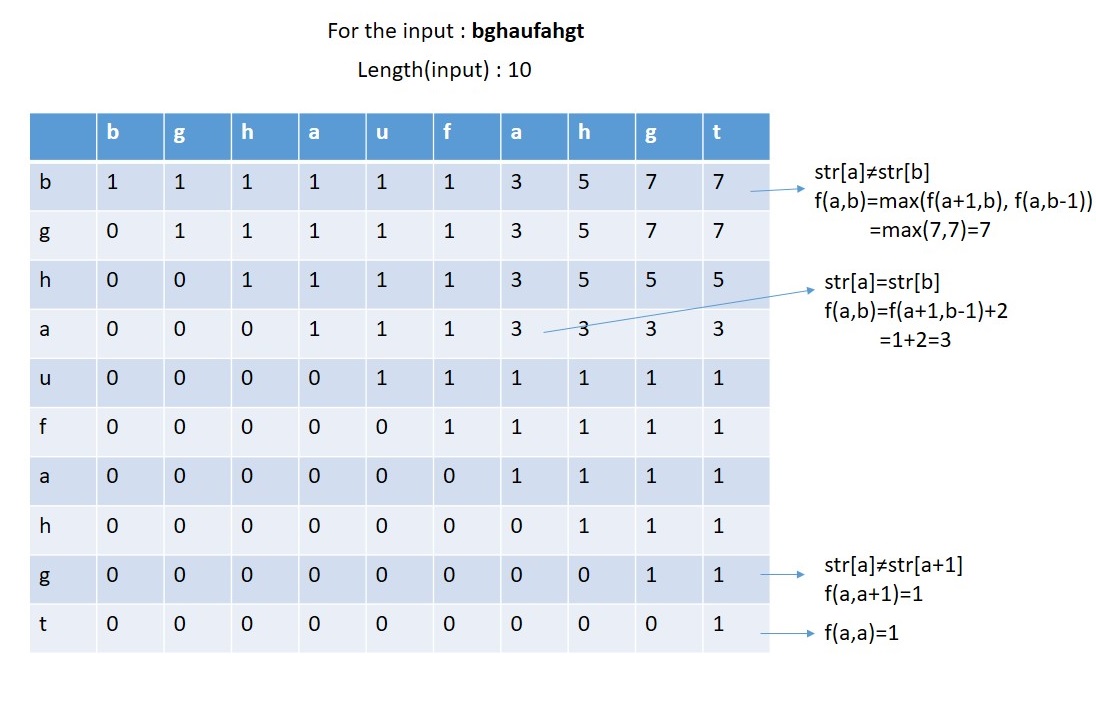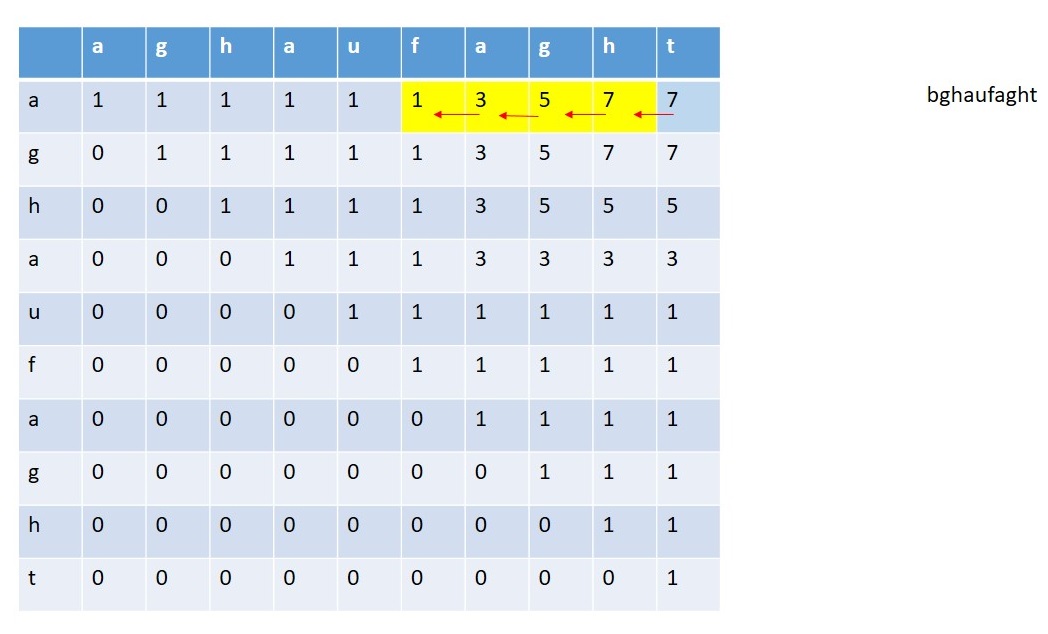Home »
Interview coding problems/challenges
Find out the longest palindromic subsequence from a string
Here, we are going to learn how to find out the longest palindromic subsequence of a string using dynamic programming?
Submitted by Souvik Saha, on March 31, 2020
Problem statement
Given a string you have to find out the longest palindromic subsequence from the given string.
Input:
T Test case
T no of input string will be given to you.
E.g.
3
bghaufahgt
souabbuos
sahajkhahas
Constrain
1≤ length (string) ≤100
Output:
Print the longest palindromic subsequence from that string
Example
T=3
Input:
bghaufahgt
Output:
ghafahg
Input:
souabbuos
Output:
soubbuos
Input:
sahajkhahas
Output:
sahajahas
Explanation with example
Let there is a string str.
Now possible arrangements are:
- Single middle characters like aba
- Paired middle characters like bb
Let, f(a,b) = length of palindromic substring from index a to index b.
Considering the above three facts:
- If there is only one character then f(a,a) = 1
- If there are two characters a and a+1 both are same then f(a,a+1) = 2 if both are not same then f(a,a+1) = 1.
-
If there is a substring starting from index a to index b then,
- If str[a] and str[b] both are same then f(a,b) = f(a+1,b-1) + 2
- If str[a] and str[b] both are not same then f(a,b)= max{ f(a+1,b) , f(a,b-1) }
For, str = bghaufahgt

To find out the characters in the palindrome we will follow this approach:
- The max length will be the top right block.
-
Every time we will check the left and bottom adjacent blocks.
- If both the blocks contain the same value then we will go for any of them.
- If any block contains a value such that the difference between the current value and the value at the block is 2 then we will go for that block and make a note of that character present in the string whose index is the same as the column number.
- When we will get the value equals to 1 then stop the traversal.

C++ Implementation
#include <bits/stdc++.h>
using namespace std;
int arr[101][101];
void print_palindrome(string str)
{
int len = str.length();
int i = 0;
int j = len - 1;
int num = arr[i][j];
vector<char> v;
int flag = 0;
while (i < len && j >= 0) {
if (num == 2) {
flag = 1;
break;
}
if (num == 1)
break;
//if the left block has the value by which
//the difference will be 2
if (arr[i][j - 1] + 2 == num) {
v.push_back(str[j]);
j--;
num = arr[i][j];
if (num == 1 || num == 2) {
v.push_back(str[j]);
}
}
//if the bottam block has the value by
//which the difference will be 2
if (arr[i + 1][j] + 2 == num) {
v.push_back(str[i]);
i++;
num = arr[i][j];
if (num == 1 || num == 2) {
v.push_back(str[i]);
}
}
if (arr[i][j - 1] == num) {
j--;
}
else {
i++;
}
}
for (int i = 0; i < v.size(); i++) {
cout << v[i];
}
//cout<<endl;
for (int i = v.size() - 1; i >= 0; i--) {
if (flag && i == v.size() - 1) {
cout << v[i];
}
else if (i != v.size() - 1) {
cout << v[i];
}
}
cout << endl;
}
void length_of_palindrom(string str)
{
int len = str.length();
memset(arr, 0, sizeof(arr));
for (int i = 0; i < len; i++) {
arr[i][i] = 1;
}
for (int i = 0; i < len - 1; i++) {
if (str[i] == str[i + 1])
arr[i][i + 1] = 2;
else
arr[i][i + 1] = 1;
}
for (int l = 3; l <= len; l++) {
for (int i = 0; i <= len - l; i++) {
int j = i + l - 1;
if (str[i] == str[j])
arr[i][j] = arr[i + 1][j - 1] + 2;
else
arr[i][j] = max(arr[i + 1][j], arr[i][j - 1]);
}
}
cout << "Palindrome : ";
print_palindrome(str);
cout << endl;
return;
}
int main()
{
int t;
cout << "Test Case : ";
cin >> t;
while (t--) {
cout << "Enter the string : ";
string str;
cin >> str;
length_of_palindrom(str);
}
}
Output
Test Case : 3
Enter the string : bghaufahgt
Palindrome : ghafahg
Enter the string : souabbuos
Palindrome : soubbuos
Enter the string : sahajkhahas
Palindrome : sahajahas
Advertisement
Advertisement